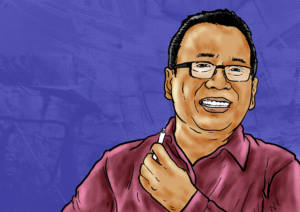In the upcoming 2024 General Elections, the determination of electoral districts is expected to be able to guarantee voter representation that will no longer alienate any communities. There were problems that occurred in the previous election, such as the merge of Bogor City and Cianjur Regency into one electoral district said to have bypassed the Bogor Regency, and the merge of Banjarmasin City and Banjar Baru City into one electoral district bypassing Banjar Regency. These are violations of the principle of unified whole or contiguous areas.
The General Election Commission (KPU) should pay attention to a number of important principles before determining the electoral districts, including equal population, preserving communities of interest, and preserving political subdivisions. These principles should be implemented to ensure elections with integrity.
Jaring.id talked to Heroik Pratama, a researcher from Perludem (Association for Elections and Democracy), and Yuko Kasuya, a Professor at the Department of Political Science, Keio University, Japan, about how the formation of electoral districts can be very crucial for society and have an impact on general elections.
***
What is the actual process of determining the electoral districts?
In his study entitled “Redistricting and Representation,” Thomas L. Brunell reveals six principles in the form of constituency boundaries. Among them, the electoral district is a unified whole (contiguous), then the formation of the electoral districts must pay attention to the unity of the region. There is also an equal population, which means that the price of seats in each electoral district is equal to that of the other electoral districts. Furthermore, maintaining the common interests of the community (preserving communities of interest), namely the formation of electoral districts takes into account similarities of social conditions of the people in one electoral district. In addition, the formation of electoral districts should maintain the integrity of the political or administrative area (preserving political subdivision), protecting the incumbent, and the compactness of the district.
This principle should be the direction in the formation of electoral districts. In Indonesia, the KPU’s work is actually regulated by Law Number 18 of 2018, which stipulates seven principles.
So far, has the KPU fulfilled that principle?
In the 2014 and 2019 elections, the issues of electoral districts remain unsolved. Bypassing of electoral districts still happened in a number of cities/districts. The KPU was proven to have violated the principle stated in the Law, which is the principle of territorial integrity.
Why is bypassing in the formation of electoral districts can be dangerous?
The electoral district issue may sound simple, but this condition will lead to other problems, especially in formulating policies. For example, in the cities of Bogor and Cianjur, if there is a bypassing of the Cianjur electoral district, how will the voices of the people in Cianjur be represented by those in Bogor? This will certainly have impacts on every decision-making process in policies. The potential for affirming the needs of residents in Cianjur may also be ignored.
How to form electoral districts ideally?
Of course, transparency and public involvement must be rethought. But to this day, the formation of electoral districts has always been considered as the affairs of the KPU. When referring to the International Standard on Electoral Boundary Delimitation, transparency and representation should not be neglected. There are five limitations: impartiality, equality, representativeness, non-discrimination, and transparency.
In a separate interview, Yuko Katsuya explained how the process of determining electoral districts was important to be monitored. In some cases, the formation of electoral districts can be infiltrated by interests. If the process is not being supervised, gerrymandering practices can occur and threaten democracy.
How do you see the issue of gerrymandering in Southeast Asia?
Gerrymandering refers to drawing electoral boundaries to favor one political party or group over another. Malapportionment means unequal seat allocation across regions/provinces/prefectures. Technically, a country can have a gerrymandering boundary drawing without having to notice a high degree of nonconformity. The US House of Representatives is one such case. In other cases like Malaysia, collusion and misrepresentation are both high.
In political science, cross-national comparative measures of conspiracies are difficult to find. While malapportionment can be compared between countries. In a paper I wrote with my colleague Yuta Kamahara, entitled “Legislative Malapportionment in Asia” in Tables 13.3 and 13.4, a comparison of malapportionment rates in various Asian countries, Malaysia has the worst level of collusion and misallocation. This is mainly due to the fact that the UMNO-based coalition has ruled the country since independence, with a brief hiatus from 2018-2020. Indonesia’s malapportionment rate is relatively low.
How did the practice of gerrymandering come about?
Gerrymandering is the result of boundary building, which can occur at some point before election day (otherwise the EMB cannot prepare ballot papers and other materials). The type of agency that defines the boundaries depends on the country.
In some cases, the final decision is made by the chief executive or parliament (as in Malaysia), and this type of decision-making process tends to allow partisan interests to infiltrate.
Are there ideal rules for managing representation before creating constituencies?
There are two main standards set by the United Nations Human Rights Committee (UNHCR), which is the United Nations agency tasked with monitoring member states’ compliance with the International Covenant on Civil and Political Rights. The first is the equal value of each voter. UNHCR states that “the principle of one person, one vote, must apply, and within the framework of each State’s electoral system, one voter’s vote must be equal to that of another”.
The second standard relates to the impartiality of boundary delimitation. UNHCR upholds, “the electoral lottery limits and the manner in which votes are allocated must not distort the distribution of voters or discriminate against any group and must not exclude or unreasonably limit the right of citizens to choose their representatives freely.”







